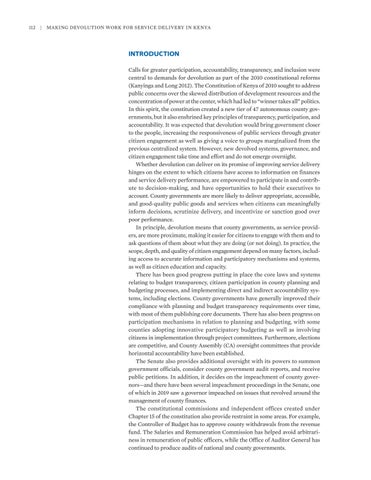112
|
Making Devolution Work for Service Delivery in Kenya
INTRODUCTION Calls for greater participation, accountability, transparency, and inclusion were central to demands for devolution as part of the 2010 constitutional reforms (Kanyinga and Long 2012). The Constitution of Kenya of 2010 sought to address public concerns over the skewed distribution of development resources and the concentration of power at the center, which had led to “winner takes all” politics. In this spirit, the constitution created a new tier of 47 autonomous county governments, but it also enshrined key principles of transparency, participation, and accountability. It was expected that devolution would bring government closer to the people, increasing the responsiveness of public services through greater citizen engagement as well as giving a voice to groups marginalized from the previous centralized system. However, new devolved systems, governance, and citizen engagement take time and effort and do not emerge overnight. Whether devolution can deliver on its promise of improving service delivery hinges on the extent to which citizens have access to information on finances and service delivery performance, are empowered to participate in and contribute to decision-making, and have opportunities to hold their executives to account. County governments are more likely to deliver appropriate, accessible, and good-quality public goods and services when citizens can meaningfully inform decisions, scrutinize delivery, and incentivize or sanction good over poor performance. In principle, devolution means that county governments, as service providers, are more proximate, making it easier for citizens to engage with them and to ask questions of them about what they are doing (or not doing). In practice, the scope, depth, and quality of citizen engagement depend on many factors, including access to accurate information and participatory mechanisms and systems, as well as citizen education and capacity. There has been good progress putting in place the core laws and systems relating to budget transparency, citizen participation in county planning and budgeting processes, and implementing direct and indirect accountability systems, including elections. County governments have generally improved their compliance with planning and budget transparency requirements over time, with most of them publishing core documents. There has also been progress on participation mechanisms in relation to planning and budgeting, with some counties adopting innovative participatory budgeting as well as involving citizens in implementation through project committees. Furthermore, elections are competitive, and County Assembly (CA) oversight committees that provide horizontal accountability have been established. The Senate also provides additional oversight with its powers to summon government officials, consider county government audit reports, and receive public petitions. In addition, it decides on the impeachment of county governors—and there have been several impeachment proceedings in the Senate, one of which in 2019 saw a governor impeached on issues that revolved around the management of county finances. The constitutional commissions and independent offices created under Chapter 15 of the constitution also provide restraint in some areas. For example, the Controller of Budget has to approve county withdrawals from the revenue fund. The Salaries and Remuneration Commission has helped avoid arbitrariness in remuneration of public officers, while the Office of Auditor General has continued to produce audits of national and county governments.


